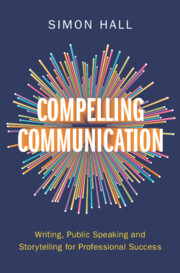163 results

Compelling Communication
- Writing, Public Speaking and Storytelling for Professional Success
-
- Published online:
- 30 May 2024
- Print publication:
- 30 May 2024
A Compelling Conclusion (Hopefully)
-
- Book:
- Compelling Communication
- Published online:
- 30 May 2024
- Print publication:
- 30 May 2024, pp 319-324
-
- Chapter
- Export citation
1 - The Foundations of Effective Communication
-
- Book:
- Compelling Communication
- Published online:
- 30 May 2024
- Print publication:
- 30 May 2024, pp 5-38
-
- Chapter
- Export citation
Chapter 3 - What Makes Solitude Great?
-
- Book:
- Solitude
- Published online:
- 24 March 2024
- Print publication:
- 18 April 2024, pp 52-64
-
- Chapter
- Export citation
Adolescent OCD Patient and Caregiver Perspectives on Identity, Authenticity, and Normalcy in Potential Deep Brain Stimulation Treatment
-
- Journal:
- Cambridge Quarterly of Healthcare Ethics , First View
- Published online by Cambridge University Press:
- 11 April 2024, pp. 1-14
-
- Article
- Export citation
Chapter 10 - Performance
- from Part II - Inspiration and Expression
-
-
- Book:
- Vaughan Williams in Context
- Published online:
- 28 March 2024
- Print publication:
- 04 April 2024, pp 86-92
-
- Chapter
- Export citation
The Authentic Liar
-
- Article
-
- You have access
- Open access
- HTML
- Export citation
16 - Advertising
- from Part III - Other Signs
-
- Book:
- Chinese Signs
- Published online:
- 29 February 2024
- Print publication:
- 07 March 2024, pp 149-159
-
- Chapter
- Export citation
1 - Political Ethics and Community Membership
- from Part I - Political Community
-
- Book:
- Statehood as Political Community
- Published online:
- 15 February 2024
- Print publication:
- 22 February 2024, pp 19-47
-
- Chapter
- Export citation
Chapter 1 - Counterfeit Money
-
- Book:
- The Theology of Debt in Late Medieval English Literature
- Published online:
- 04 January 2024
- Print publication:
- 18 January 2024, pp 25-49
-
- Chapter
-
- You have access
- HTML
- Export citation
“These Somalis are not Somalis:” Cup of Art Italian Coffeehouse, Authentic Identities, and Belonging in Hargeisa, Somaliland
-
- Journal:
- African Studies Review , First View
- Published online by Cambridge University Press:
- 22 December 2023, pp. 1-20
-
- Article
-
- You have access
- Open access
- HTML
- Export citation
18 - Menus and maps: How can I make my classroom more authentic in terms of materials and practices?
- from Part IV - Lesson and Unit Planning
-
- Book:
- The Art and Science of Language Teaching
- Published online:
- 21 December 2023
- Print publication:
- 21 December 2023, pp 266-282
-
- Chapter
- Export citation
How might cancer patients experience existential guilt? A qualitative research
-
- Journal:
- Palliative & Supportive Care / Volume 22 / Issue 2 / April 2024
- Published online by Cambridge University Press:
- 14 December 2023, pp. 381-386
-
- Article
- Export citation
Leader Authenticity and Ethics: A Heideggerian Perspective
-
- Journal:
- Business Ethics Quarterly , First View
- Published online by Cambridge University Press:
- 28 November 2023, pp. 1-20
-
- Article
- Export citation
7 - The Good of Personal Liberty
- from Part II - Critical Legal Moralism
-
- Book:
- Enforcing Morality
- Published online:
- 03 November 2023
- Print publication:
- 16 November 2023, pp 131-149
-
- Chapter
- Export citation
From South America to the United States: Guayakí and the Transformation of Yerba Mate
-
- Journal:
- Enterprise & Society , First View
- Published online by Cambridge University Press:
- 10 November 2023, pp. 1-26
-
- Article
-
- You have access
- Open access
- HTML
- Export citation
In the future, toward death: Finance capitalism and security in Don DeLillo's ‘Cosmopolis’
-
- Journal:
- Finance and Society / Volume 4 / Issue 1 / 2018
- Published online by Cambridge University Press:
- 09 November 2023, pp. 76-91
-
- Article
-
- You have access
- Open access
- Export citation
Excavating the field of heritage law: support, renewal, and iconoclasm
-
- Journal:
- International Journal of Cultural Property , First View
- Published online by Cambridge University Press:
- 07 November 2023, pp. 1-16
-
- Article
- Export citation
Chapter 16 - Principles for a professional practice
- from Part Two - Professional practice
-
- Book:
- Editing for Sensitivity, Diversity and Inclusion
- Published online:
- 24 August 2023
- Print publication:
- 29 August 2023, pp 152-160
-
- Chapter
- Export citation
Chapter 7 - Plagiarism
- from Part Two - Professional practice
-
- Book:
- Editing for Sensitivity, Diversity and Inclusion
- Published online:
- 24 August 2023
- Print publication:
- 29 August 2023, pp 61-65
-
- Chapter
- Export citation



